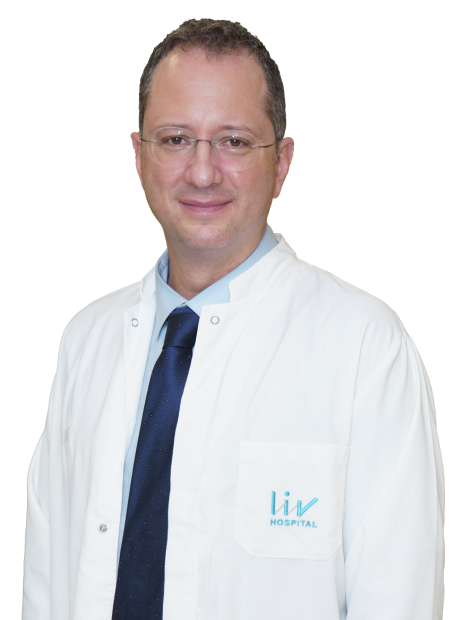Chronic Venous Disease
Chronic venous are characterized by noticeable veins in the legs, along with symptoms such as pain, swelling, and a feeling of heaviness. These symptoms can significantly impact quality of life. If left untreated in the early stages, varicose veins may lead to serious health complications.

What is Chronic Venous?
Chronic venous disease occurs when the veins in the legs fail to efficiently return blood to the heart. The most common manifestation is varicose veins enlarged, raised, and twisted veins visible on the legs. In advanced stages, the condition can lead to darkening of the skin and the formation of sores around the ankles.
What Causes Varicose Veins?
The veins in the leg are responsible for carrying blood from the foot back to the heart, working against gravity when we stand or walk. Healthy veins have strong walls and one-way valves that ensure blood flows toward the heart and prevent it from flowing backward. When the walls of a vein become weak and expand, the valves can no longer close properly, causing blood to leak and pool in the leg.
This leads to increased pressure and the development of varicose veins. While the exact reason for these changes isn't always known, inflammation and genetics play significant roles. In some cases, a previous blood clot (deep vein thrombosis) can block the main vein, increasing backflow and further raising pressure in the veins.
Which Veins Cause Varicose Veins?
In the leg, there is a superficial vein system that runs between the skin and muscles, a deep vein system that runs within the muscles and bridge veins that connect these two systems. Varicose veins are most commonly caused by a deterioration in the superficial vein system. Varicose veins that appear on the skin are usually branches of the superficial veins. More rarely, a clot in the deep vein system can also cause venous insufficiency.
What Are the Symptoms of Varicose Veins?
The most common complaints related to varicose veins are visible vein changes and pain. Pain from venous insufficiency often feels like a sense of fullness, restlessness, or tension that typically worsens with prolonged sitting or standing, but is not usually sharp. Symptoms tend to intensify after long periods of standing or in the evening, while walking and movement generally provide relief. Muscle cramps, particularly at night, are common, along with fatigue, heaviness, and numbness in the calves. As the disease progresses, symptoms such as swelling (edema), burning, pain, and itching may appear. In advanced stages, dark skin discoloration and even sores can develop, especially near the ankle.
Is Varicose Veins Genetic?
While genetics can predispose a person to varicose veins, nutrition and lifestyle are significant contributing factors. Activities or situations that increase intra-abdominal pressure”such as being overweight, having a tall stature, experiencing prolonged constipation or heavy lifting, sitting or standing for long periods, wearing tight clothing, or frequently using high heels”increase the risk of developing varicose veins.
How Are Varicose Veins Diagnosed?
Diagnosing varicose veins involves assessing the patient's medical history and performing a physical examination. Doppler ultrasonography is then used to evaluate for underlying venous insufficiency and to map the affected veins. This imaging test helps determine whether a patient has chronic venous disease and whether they are a suitable candidate for further intervention.
What Increases Varicose Veins?
Research highlights that excess weight and a history of venous obstruction are significant risk factors for developing varicose veins. Studies show that about 30% of individuals who have no symptoms, but are found to have venous insufficiency on Doppler ultrasound, will develop visible varicose veins within four years.
Does Varicose Veins Cause Restless Leg Syndrome?
Varicose veins are a leading underlying cause of restless leg syndrome. Therefore, anyone experiencing symptoms of restless leg syndrome should also be evaluated for possible venous insufficiency.
What Is the Most Common Method of Varicose Vein Treatment?
If significant insufficiency is detected in the main veins (the great and small saphenous veins) and the veins are enlarged, surgical intervention is typically required. Thanks to modern technology, these operations can now be performed on an outpatient basis, without the need for general anesthesia, and through very small incisions. The most commonly used techniques are thermal methods (such as radiofrequency or laser) and adhesive procedures.
Is It Possible to Stop Varicose Veins?
Varicose veins tend to progress gradually over time. In the early stages, their progression can be significantly slowed with measures such as regular leg and core muscle exercises, weight loss, elevating the legs while resting, medication, wearing compression stockings, preventing constipation, and maintaining a diet high in fiber. However, these measures cannot completely halt the condition.
How to Treat Varicose Veins in the Elderly?
Approximately 30% of patients seeking treatment for varicose veins are aged 65 and older. In this age group, the presence of additional conditions such as diabetes, pulmonary or vascular disease, cancer, stroke, and heart problems can complicate treatment. Thermal and adhesive procedures are generally safe and effective for elderly patients, but careful planning is crucial. It is also important to note that advanced age increases the risk of treated veins reopening in the future.
* Liv Hospital Editorial Board has contributed to the publication of this content .
* Contents of this page is for informational purposes only. Please consult your doctor for diagnosis and treatment. The content of this page does not include information on medicinal health care at Liv Hospital .
For more information about our academic and training initiatives, visit Liv Hospital Academy


